Management Accounting - Sample Assignment
VerifiedAdded on 2021/05/31
|12
|2928
|36
AI Summary
Contribute Materials
Your contribution can guide someone’s learning journey. Share your
documents today.
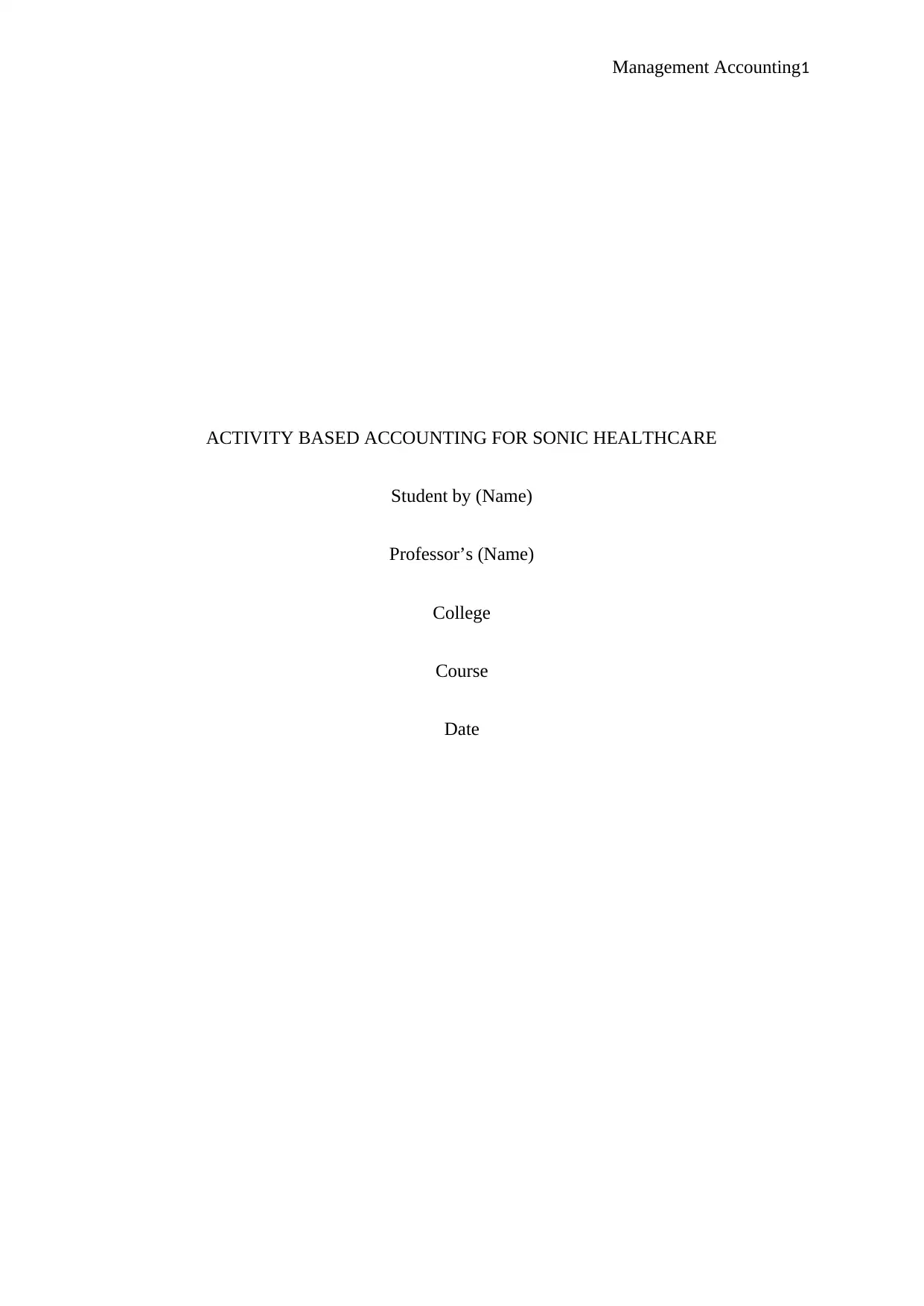
Management Accounting1
ACTIVITY BASED ACCOUNTING FOR SONIC HEALTHCARE
Student by (Name)
Professor’s (Name)
College
Course
Date
ACTIVITY BASED ACCOUNTING FOR SONIC HEALTHCARE
Student by (Name)
Professor’s (Name)
College
Course
Date
Secure Best Marks with AI Grader
Need help grading? Try our AI Grader for instant feedback on your assignments.
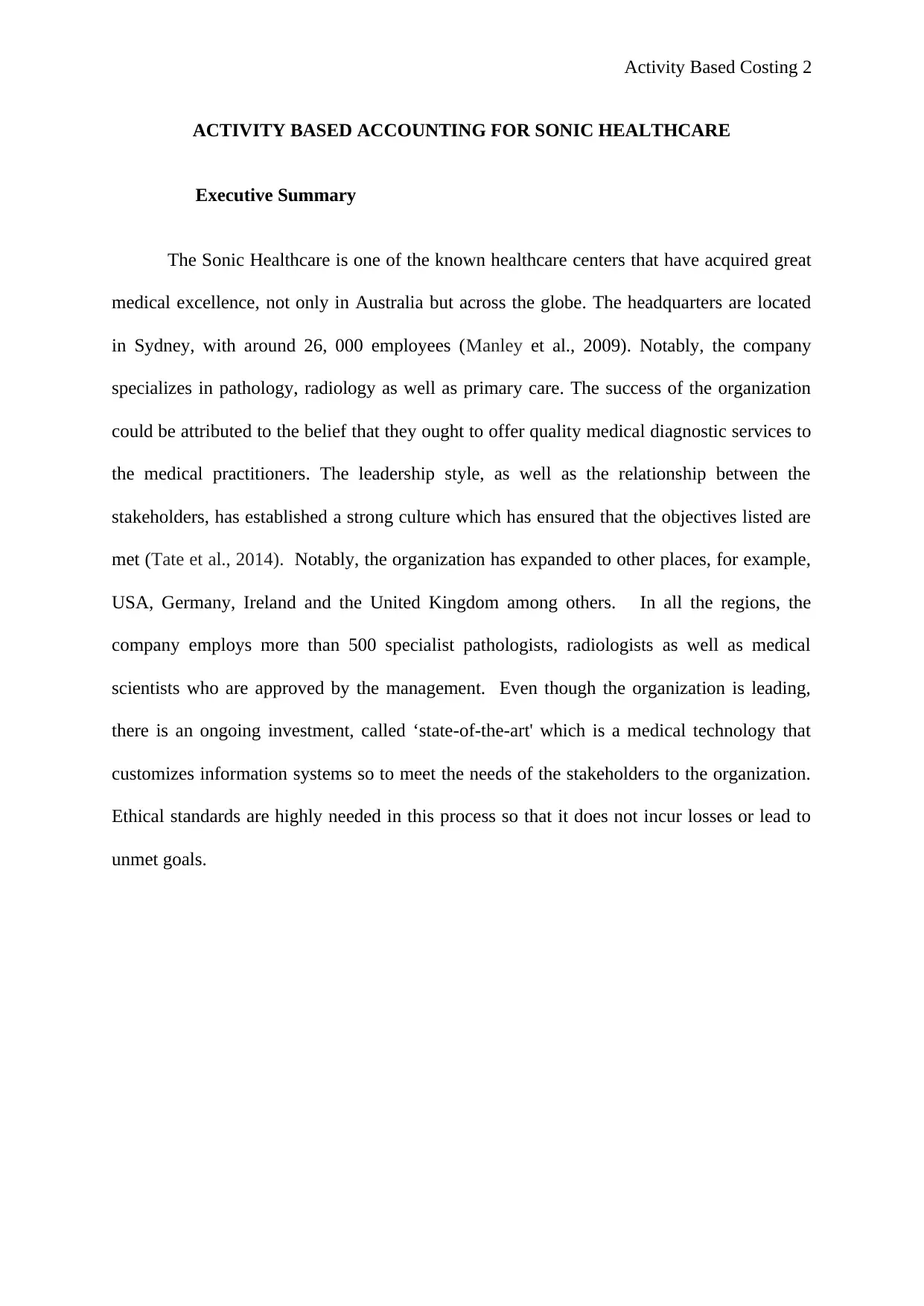
Activity Based Costing 2
ACTIVITY BASED ACCOUNTING FOR SONIC HEALTHCARE
Executive Summary
The Sonic Healthcare is one of the known healthcare centers that have acquired great
medical excellence, not only in Australia but across the globe. The headquarters are located
in Sydney, with around 26, 000 employees (Manley et al., 2009). Notably, the company
specializes in pathology, radiology as well as primary care. The success of the organization
could be attributed to the belief that they ought to offer quality medical diagnostic services to
the medical practitioners. The leadership style, as well as the relationship between the
stakeholders, has established a strong culture which has ensured that the objectives listed are
met (Tate et al., 2014). Notably, the organization has expanded to other places, for example,
USA, Germany, Ireland and the United Kingdom among others. In all the regions, the
company employs more than 500 specialist pathologists, radiologists as well as medical
scientists who are approved by the management. Even though the organization is leading,
there is an ongoing investment, called ‘state-of-the-art' which is a medical technology that
customizes information systems so to meet the needs of the stakeholders to the organization.
Ethical standards are highly needed in this process so that it does not incur losses or lead to
unmet goals.
ACTIVITY BASED ACCOUNTING FOR SONIC HEALTHCARE
Executive Summary
The Sonic Healthcare is one of the known healthcare centers that have acquired great
medical excellence, not only in Australia but across the globe. The headquarters are located
in Sydney, with around 26, 000 employees (Manley et al., 2009). Notably, the company
specializes in pathology, radiology as well as primary care. The success of the organization
could be attributed to the belief that they ought to offer quality medical diagnostic services to
the medical practitioners. The leadership style, as well as the relationship between the
stakeholders, has established a strong culture which has ensured that the objectives listed are
met (Tate et al., 2014). Notably, the organization has expanded to other places, for example,
USA, Germany, Ireland and the United Kingdom among others. In all the regions, the
company employs more than 500 specialist pathologists, radiologists as well as medical
scientists who are approved by the management. Even though the organization is leading,
there is an ongoing investment, called ‘state-of-the-art' which is a medical technology that
customizes information systems so to meet the needs of the stakeholders to the organization.
Ethical standards are highly needed in this process so that it does not incur losses or lead to
unmet goals.
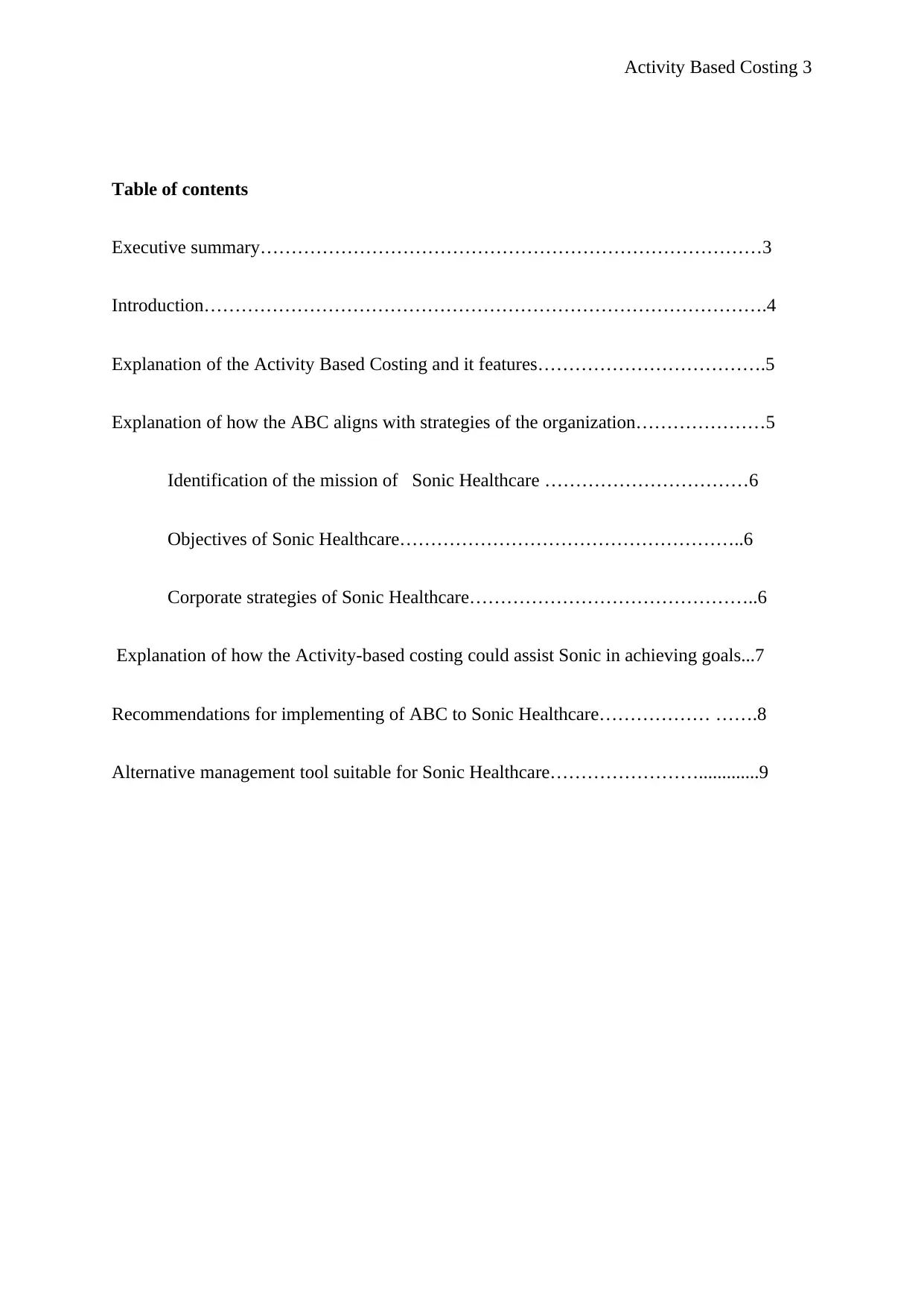
Activity Based Costing 3
Table of contents
Executive summary………………………………………………………………………3
Introduction……………………………………………………………………………….4
Explanation of the Activity Based Costing and it features……………………………….5
Explanation of how the ABC aligns with strategies of the organization…………………5
Identification of the mission of Sonic Healthcare ……………………………6
Objectives of Sonic Healthcare………………………………………………..6
Corporate strategies of Sonic Healthcare………………………………………..6
Explanation of how the Activity-based costing could assist Sonic in achieving goals...7
Recommendations for implementing of ABC to Sonic Healthcare……………… …….8
Alternative management tool suitable for Sonic Healthcare…………………….............9
Table of contents
Executive summary………………………………………………………………………3
Introduction……………………………………………………………………………….4
Explanation of the Activity Based Costing and it features……………………………….5
Explanation of how the ABC aligns with strategies of the organization…………………5
Identification of the mission of Sonic Healthcare ……………………………6
Objectives of Sonic Healthcare………………………………………………..6
Corporate strategies of Sonic Healthcare………………………………………..6
Explanation of how the Activity-based costing could assist Sonic in achieving goals...7
Recommendations for implementing of ABC to Sonic Healthcare……………… …….8
Alternative management tool suitable for Sonic Healthcare…………………….............9
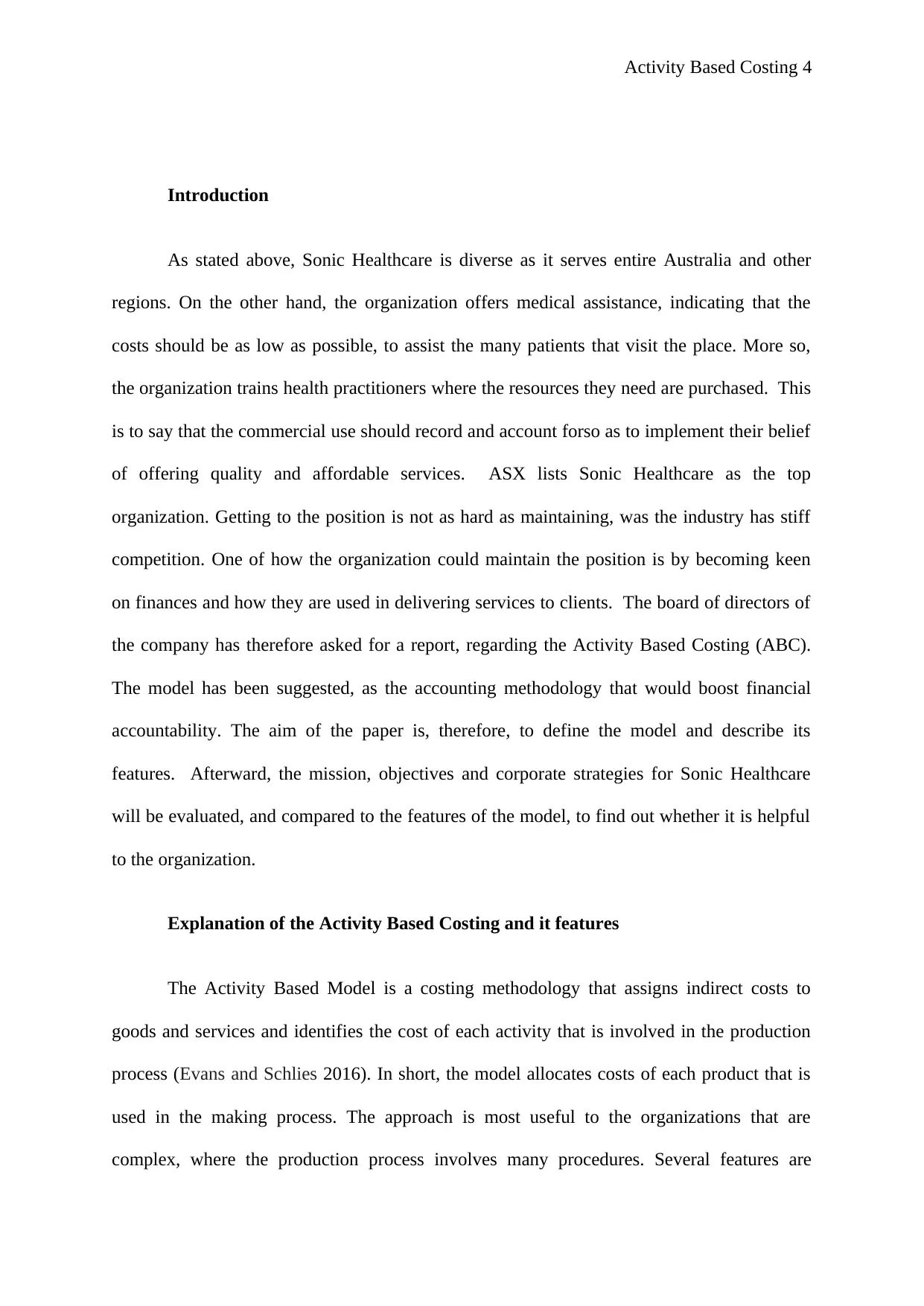
Activity Based Costing 4
Introduction
As stated above, Sonic Healthcare is diverse as it serves entire Australia and other
regions. On the other hand, the organization offers medical assistance, indicating that the
costs should be as low as possible, to assist the many patients that visit the place. More so,
the organization trains health practitioners where the resources they need are purchased. This
is to say that the commercial use should record and account forso as to implement their belief
of offering quality and affordable services. ASX lists Sonic Healthcare as the top
organization. Getting to the position is not as hard as maintaining, was the industry has stiff
competition. One of how the organization could maintain the position is by becoming keen
on finances and how they are used in delivering services to clients. The board of directors of
the company has therefore asked for a report, regarding the Activity Based Costing (ABC).
The model has been suggested, as the accounting methodology that would boost financial
accountability. The aim of the paper is, therefore, to define the model and describe its
features. Afterward, the mission, objectives and corporate strategies for Sonic Healthcare
will be evaluated, and compared to the features of the model, to find out whether it is helpful
to the organization.
Explanation of the Activity Based Costing and it features
The Activity Based Model is a costing methodology that assigns indirect costs to
goods and services and identifies the cost of each activity that is involved in the production
process (Evans and Schlies 2016). In short, the model allocates costs of each product that is
used in the making process. The approach is most useful to the organizations that are
complex, where the production process involves many procedures. Several features are
Introduction
As stated above, Sonic Healthcare is diverse as it serves entire Australia and other
regions. On the other hand, the organization offers medical assistance, indicating that the
costs should be as low as possible, to assist the many patients that visit the place. More so,
the organization trains health practitioners where the resources they need are purchased. This
is to say that the commercial use should record and account forso as to implement their belief
of offering quality and affordable services. ASX lists Sonic Healthcare as the top
organization. Getting to the position is not as hard as maintaining, was the industry has stiff
competition. One of how the organization could maintain the position is by becoming keen
on finances and how they are used in delivering services to clients. The board of directors of
the company has therefore asked for a report, regarding the Activity Based Costing (ABC).
The model has been suggested, as the accounting methodology that would boost financial
accountability. The aim of the paper is, therefore, to define the model and describe its
features. Afterward, the mission, objectives and corporate strategies for Sonic Healthcare
will be evaluated, and compared to the features of the model, to find out whether it is helpful
to the organization.
Explanation of the Activity Based Costing and it features
The Activity Based Model is a costing methodology that assigns indirect costs to
goods and services and identifies the cost of each activity that is involved in the production
process (Evans and Schlies 2016). In short, the model allocates costs of each product that is
used in the making process. The approach is most useful to the organizations that are
complex, where the production process involves many procedures. Several features are
Secure Best Marks with AI Grader
Need help grading? Try our AI Grader for instant feedback on your assignments.
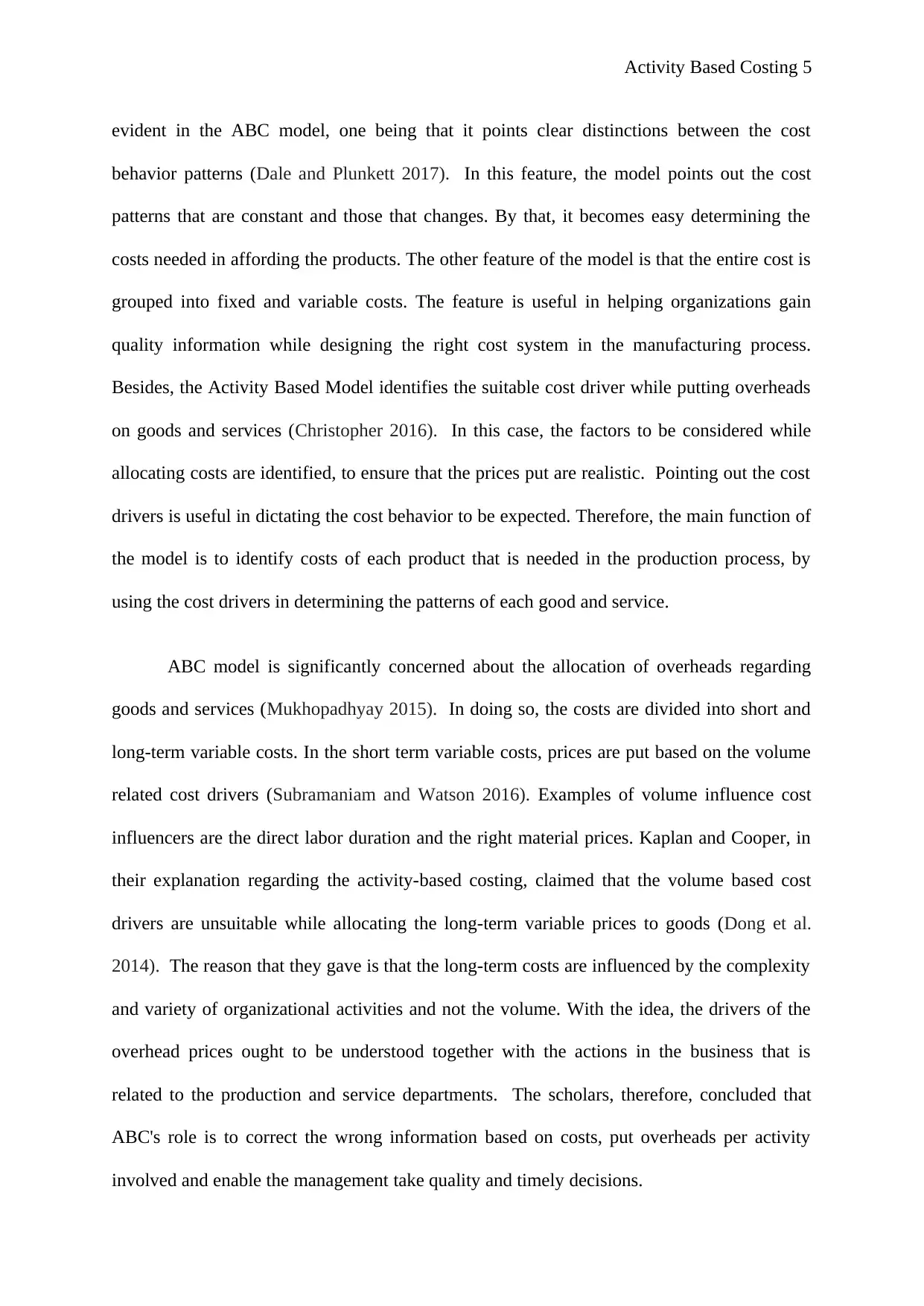
Activity Based Costing 5
evident in the ABC model, one being that it points clear distinctions between the cost
behavior patterns (Dale and Plunkett 2017). In this feature, the model points out the cost
patterns that are constant and those that changes. By that, it becomes easy determining the
costs needed in affording the products. The other feature of the model is that the entire cost is
grouped into fixed and variable costs. The feature is useful in helping organizations gain
quality information while designing the right cost system in the manufacturing process.
Besides, the Activity Based Model identifies the suitable cost driver while putting overheads
on goods and services (Christopher 2016). In this case, the factors to be considered while
allocating costs are identified, to ensure that the prices put are realistic. Pointing out the cost
drivers is useful in dictating the cost behavior to be expected. Therefore, the main function of
the model is to identify costs of each product that is needed in the production process, by
using the cost drivers in determining the patterns of each good and service.
ABC model is significantly concerned about the allocation of overheads regarding
goods and services (Mukhopadhyay 2015). In doing so, the costs are divided into short and
long-term variable costs. In the short term variable costs, prices are put based on the volume
related cost drivers (Subramaniam and Watson 2016). Examples of volume influence cost
influencers are the direct labor duration and the right material prices. Kaplan and Cooper, in
their explanation regarding the activity-based costing, claimed that the volume based cost
drivers are unsuitable while allocating the long-term variable prices to goods (Dong et al.
2014). The reason that they gave is that the long-term costs are influenced by the complexity
and variety of organizational activities and not the volume. With the idea, the drivers of the
overhead prices ought to be understood together with the actions in the business that is
related to the production and service departments. The scholars, therefore, concluded that
ABC's role is to correct the wrong information based on costs, put overheads per activity
involved and enable the management take quality and timely decisions.
evident in the ABC model, one being that it points clear distinctions between the cost
behavior patterns (Dale and Plunkett 2017). In this feature, the model points out the cost
patterns that are constant and those that changes. By that, it becomes easy determining the
costs needed in affording the products. The other feature of the model is that the entire cost is
grouped into fixed and variable costs. The feature is useful in helping organizations gain
quality information while designing the right cost system in the manufacturing process.
Besides, the Activity Based Model identifies the suitable cost driver while putting overheads
on goods and services (Christopher 2016). In this case, the factors to be considered while
allocating costs are identified, to ensure that the prices put are realistic. Pointing out the cost
drivers is useful in dictating the cost behavior to be expected. Therefore, the main function of
the model is to identify costs of each product that is needed in the production process, by
using the cost drivers in determining the patterns of each good and service.
ABC model is significantly concerned about the allocation of overheads regarding
goods and services (Mukhopadhyay 2015). In doing so, the costs are divided into short and
long-term variable costs. In the short term variable costs, prices are put based on the volume
related cost drivers (Subramaniam and Watson 2016). Examples of volume influence cost
influencers are the direct labor duration and the right material prices. Kaplan and Cooper, in
their explanation regarding the activity-based costing, claimed that the volume based cost
drivers are unsuitable while allocating the long-term variable prices to goods (Dong et al.
2014). The reason that they gave is that the long-term costs are influenced by the complexity
and variety of organizational activities and not the volume. With the idea, the drivers of the
overhead prices ought to be understood together with the actions in the business that is
related to the production and service departments. The scholars, therefore, concluded that
ABC's role is to correct the wrong information based on costs, put overheads per activity
involved and enable the management take quality and timely decisions.
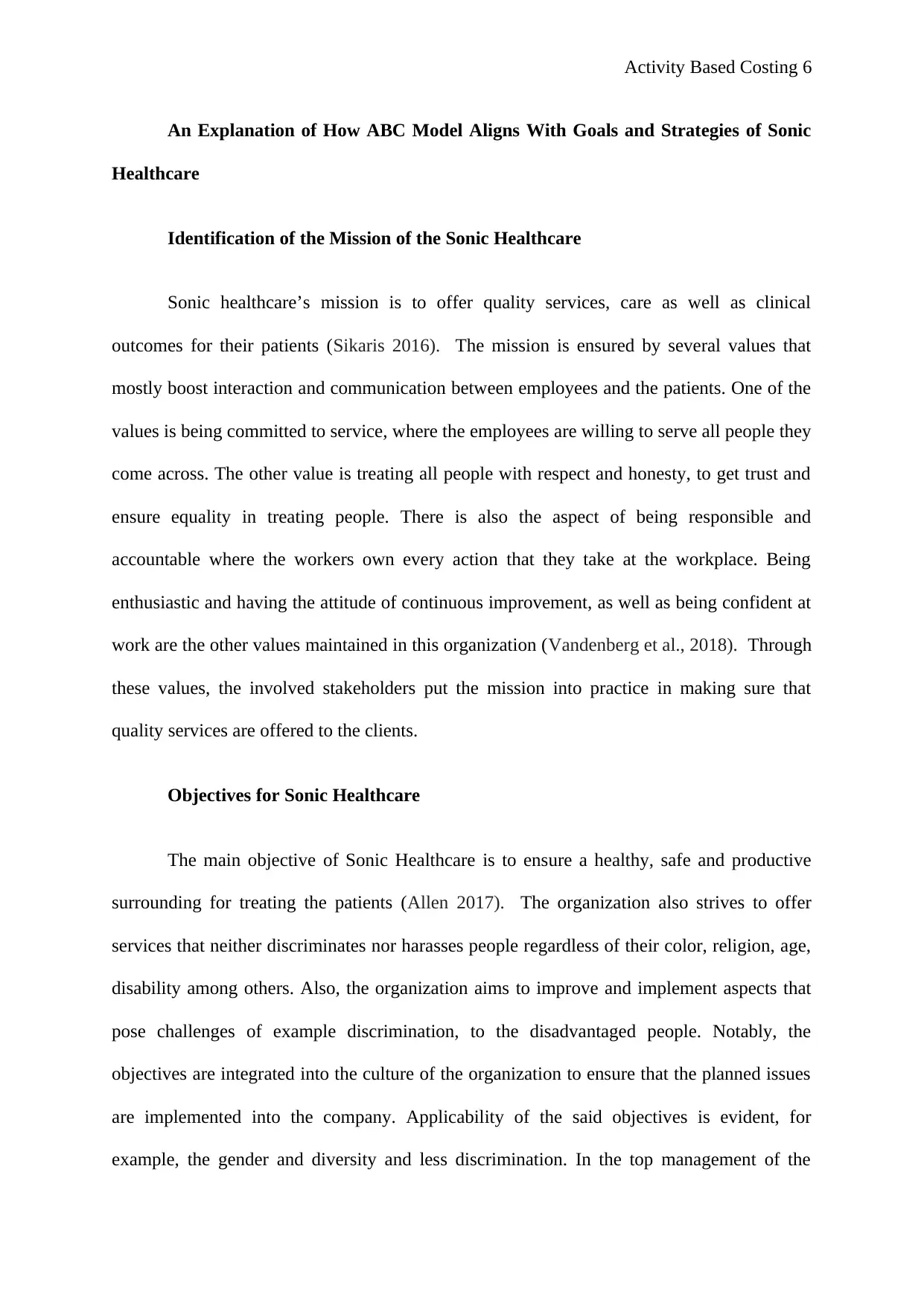
Activity Based Costing 6
An Explanation of How ABC Model Aligns With Goals and Strategies of Sonic
Healthcare
Identification of the Mission of the Sonic Healthcare
Sonic healthcare’s mission is to offer quality services, care as well as clinical
outcomes for their patients (Sikaris 2016). The mission is ensured by several values that
mostly boost interaction and communication between employees and the patients. One of the
values is being committed to service, where the employees are willing to serve all people they
come across. The other value is treating all people with respect and honesty, to get trust and
ensure equality in treating people. There is also the aspect of being responsible and
accountable where the workers own every action that they take at the workplace. Being
enthusiastic and having the attitude of continuous improvement, as well as being confident at
work are the other values maintained in this organization (Vandenberg et al., 2018). Through
these values, the involved stakeholders put the mission into practice in making sure that
quality services are offered to the clients.
Objectives for Sonic Healthcare
The main objective of Sonic Healthcare is to ensure a healthy, safe and productive
surrounding for treating the patients (Allen 2017). The organization also strives to offer
services that neither discriminates nor harasses people regardless of their color, religion, age,
disability among others. Also, the organization aims to improve and implement aspects that
pose challenges of example discrimination, to the disadvantaged people. Notably, the
objectives are integrated into the culture of the organization to ensure that the planned issues
are implemented into the company. Applicability of the said objectives is evident, for
example, the gender and diversity and less discrimination. In the top management of the
An Explanation of How ABC Model Aligns With Goals and Strategies of Sonic
Healthcare
Identification of the Mission of the Sonic Healthcare
Sonic healthcare’s mission is to offer quality services, care as well as clinical
outcomes for their patients (Sikaris 2016). The mission is ensured by several values that
mostly boost interaction and communication between employees and the patients. One of the
values is being committed to service, where the employees are willing to serve all people they
come across. The other value is treating all people with respect and honesty, to get trust and
ensure equality in treating people. There is also the aspect of being responsible and
accountable where the workers own every action that they take at the workplace. Being
enthusiastic and having the attitude of continuous improvement, as well as being confident at
work are the other values maintained in this organization (Vandenberg et al., 2018). Through
these values, the involved stakeholders put the mission into practice in making sure that
quality services are offered to the clients.
Objectives for Sonic Healthcare
The main objective of Sonic Healthcare is to ensure a healthy, safe and productive
surrounding for treating the patients (Allen 2017). The organization also strives to offer
services that neither discriminates nor harasses people regardless of their color, religion, age,
disability among others. Also, the organization aims to improve and implement aspects that
pose challenges of example discrimination, to the disadvantaged people. Notably, the
objectives are integrated into the culture of the organization to ensure that the planned issues
are implemented into the company. Applicability of the said objectives is evident, for
example, the gender and diversity and less discrimination. In the top management of the
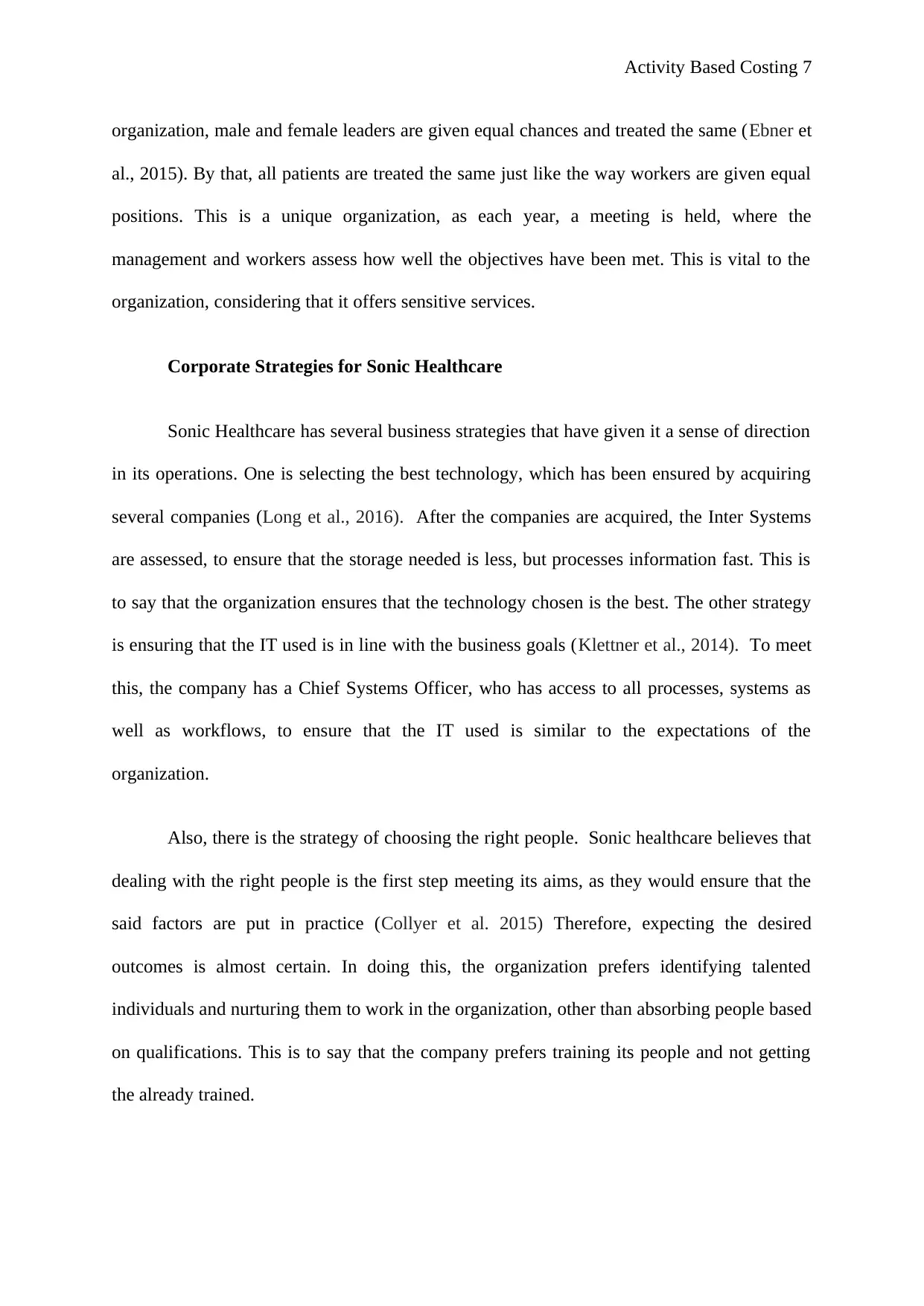
Activity Based Costing 7
organization, male and female leaders are given equal chances and treated the same (Ebner et
al., 2015). By that, all patients are treated the same just like the way workers are given equal
positions. This is a unique organization, as each year, a meeting is held, where the
management and workers assess how well the objectives have been met. This is vital to the
organization, considering that it offers sensitive services.
Corporate Strategies for Sonic Healthcare
Sonic Healthcare has several business strategies that have given it a sense of direction
in its operations. One is selecting the best technology, which has been ensured by acquiring
several companies (Long et al., 2016). After the companies are acquired, the Inter Systems
are assessed, to ensure that the storage needed is less, but processes information fast. This is
to say that the organization ensures that the technology chosen is the best. The other strategy
is ensuring that the IT used is in line with the business goals (Klettner et al., 2014). To meet
this, the company has a Chief Systems Officer, who has access to all processes, systems as
well as workflows, to ensure that the IT used is similar to the expectations of the
organization.
Also, there is the strategy of choosing the right people. Sonic healthcare believes that
dealing with the right people is the first step meeting its aims, as they would ensure that the
said factors are put in practice (Collyer et al. 2015) Therefore, expecting the desired
outcomes is almost certain. In doing this, the organization prefers identifying talented
individuals and nurturing them to work in the organization, other than absorbing people based
on qualifications. This is to say that the company prefers training its people and not getting
the already trained.
organization, male and female leaders are given equal chances and treated the same (Ebner et
al., 2015). By that, all patients are treated the same just like the way workers are given equal
positions. This is a unique organization, as each year, a meeting is held, where the
management and workers assess how well the objectives have been met. This is vital to the
organization, considering that it offers sensitive services.
Corporate Strategies for Sonic Healthcare
Sonic Healthcare has several business strategies that have given it a sense of direction
in its operations. One is selecting the best technology, which has been ensured by acquiring
several companies (Long et al., 2016). After the companies are acquired, the Inter Systems
are assessed, to ensure that the storage needed is less, but processes information fast. This is
to say that the organization ensures that the technology chosen is the best. The other strategy
is ensuring that the IT used is in line with the business goals (Klettner et al., 2014). To meet
this, the company has a Chief Systems Officer, who has access to all processes, systems as
well as workflows, to ensure that the IT used is similar to the expectations of the
organization.
Also, there is the strategy of choosing the right people. Sonic healthcare believes that
dealing with the right people is the first step meeting its aims, as they would ensure that the
said factors are put in practice (Collyer et al. 2015) Therefore, expecting the desired
outcomes is almost certain. In doing this, the organization prefers identifying talented
individuals and nurturing them to work in the organization, other than absorbing people based
on qualifications. This is to say that the company prefers training its people and not getting
the already trained.
Paraphrase This Document
Need a fresh take? Get an instant paraphrase of this document with our AI Paraphraser
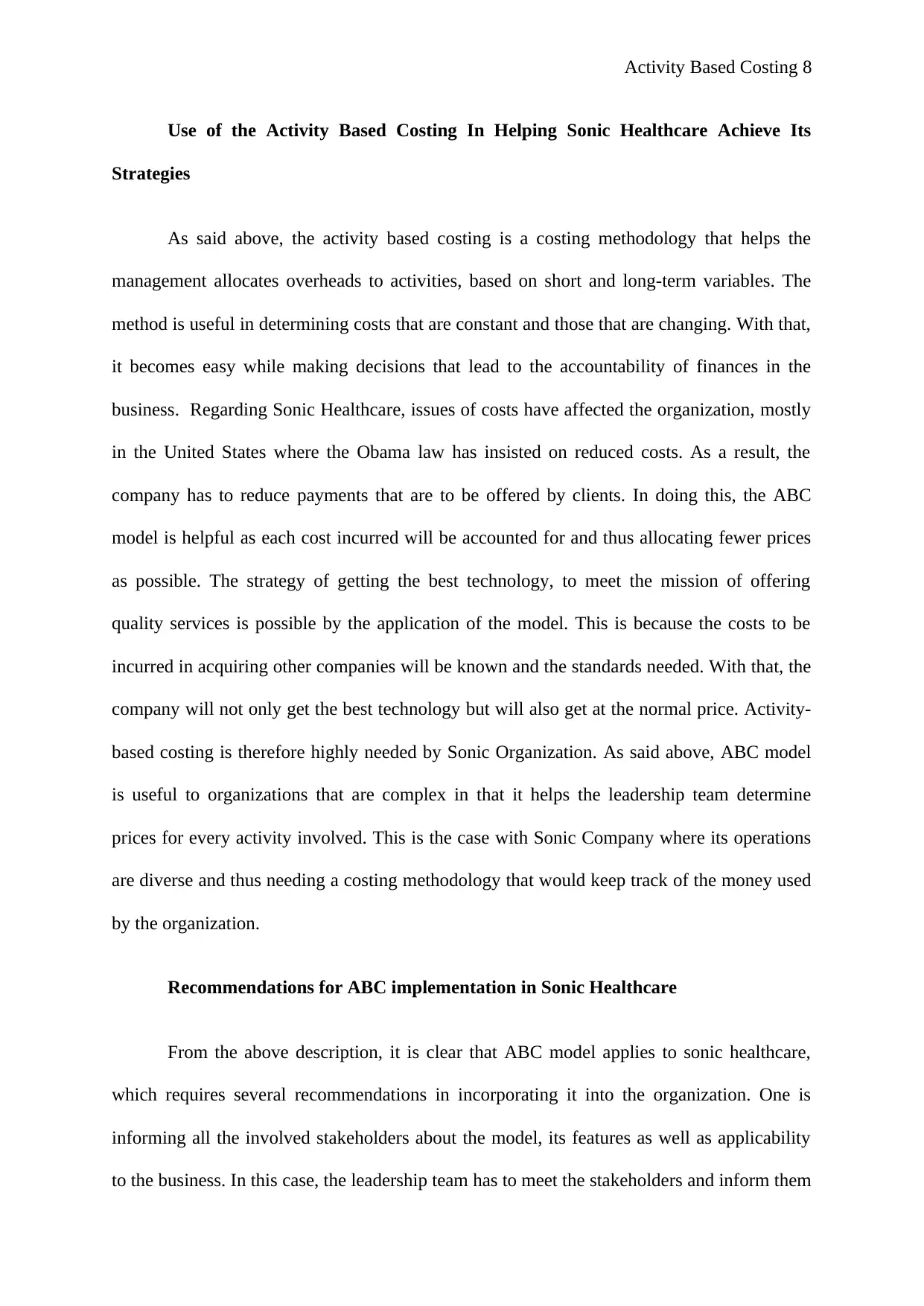
Activity Based Costing 8
Use of the Activity Based Costing In Helping Sonic Healthcare Achieve Its
Strategies
As said above, the activity based costing is a costing methodology that helps the
management allocates overheads to activities, based on short and long-term variables. The
method is useful in determining costs that are constant and those that are changing. With that,
it becomes easy while making decisions that lead to the accountability of finances in the
business. Regarding Sonic Healthcare, issues of costs have affected the organization, mostly
in the United States where the Obama law has insisted on reduced costs. As a result, the
company has to reduce payments that are to be offered by clients. In doing this, the ABC
model is helpful as each cost incurred will be accounted for and thus allocating fewer prices
as possible. The strategy of getting the best technology, to meet the mission of offering
quality services is possible by the application of the model. This is because the costs to be
incurred in acquiring other companies will be known and the standards needed. With that, the
company will not only get the best technology but will also get at the normal price. Activity-
based costing is therefore highly needed by Sonic Organization. As said above, ABC model
is useful to organizations that are complex in that it helps the leadership team determine
prices for every activity involved. This is the case with Sonic Company where its operations
are diverse and thus needing a costing methodology that would keep track of the money used
by the organization.
Recommendations for ABC implementation in Sonic Healthcare
From the above description, it is clear that ABC model applies to sonic healthcare,
which requires several recommendations in incorporating it into the organization. One is
informing all the involved stakeholders about the model, its features as well as applicability
to the business. In this case, the leadership team has to meet the stakeholders and inform them
Use of the Activity Based Costing In Helping Sonic Healthcare Achieve Its
Strategies
As said above, the activity based costing is a costing methodology that helps the
management allocates overheads to activities, based on short and long-term variables. The
method is useful in determining costs that are constant and those that are changing. With that,
it becomes easy while making decisions that lead to the accountability of finances in the
business. Regarding Sonic Healthcare, issues of costs have affected the organization, mostly
in the United States where the Obama law has insisted on reduced costs. As a result, the
company has to reduce payments that are to be offered by clients. In doing this, the ABC
model is helpful as each cost incurred will be accounted for and thus allocating fewer prices
as possible. The strategy of getting the best technology, to meet the mission of offering
quality services is possible by the application of the model. This is because the costs to be
incurred in acquiring other companies will be known and the standards needed. With that, the
company will not only get the best technology but will also get at the normal price. Activity-
based costing is therefore highly needed by Sonic Organization. As said above, ABC model
is useful to organizations that are complex in that it helps the leadership team determine
prices for every activity involved. This is the case with Sonic Company where its operations
are diverse and thus needing a costing methodology that would keep track of the money used
by the organization.
Recommendations for ABC implementation in Sonic Healthcare
From the above description, it is clear that ABC model applies to sonic healthcare,
which requires several recommendations in incorporating it into the organization. One is
informing all the involved stakeholders about the model, its features as well as applicability
to the business. In this case, the leadership team has to meet the stakeholders and inform them
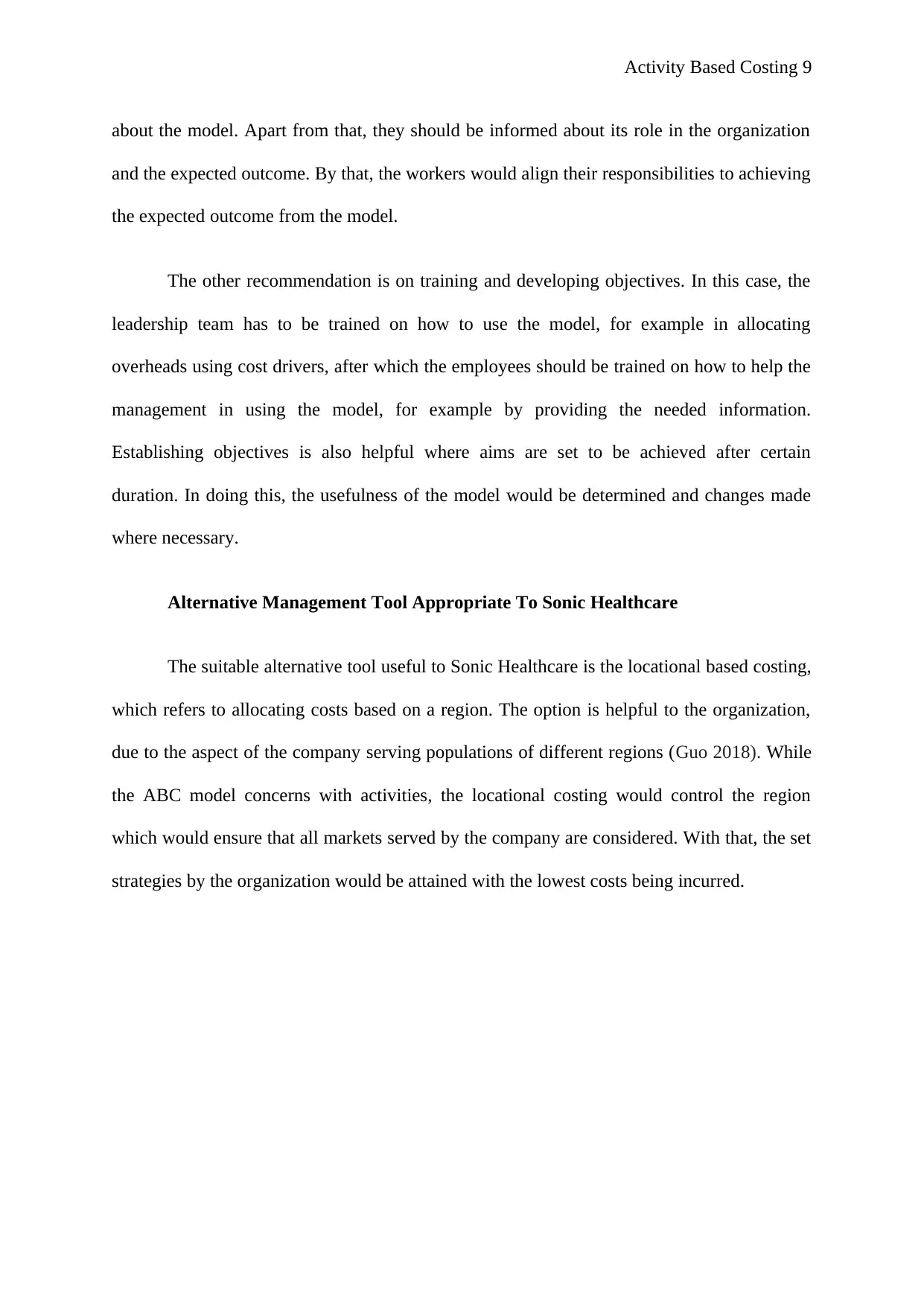
Activity Based Costing 9
about the model. Apart from that, they should be informed about its role in the organization
and the expected outcome. By that, the workers would align their responsibilities to achieving
the expected outcome from the model.
The other recommendation is on training and developing objectives. In this case, the
leadership team has to be trained on how to use the model, for example in allocating
overheads using cost drivers, after which the employees should be trained on how to help the
management in using the model, for example by providing the needed information.
Establishing objectives is also helpful where aims are set to be achieved after certain
duration. In doing this, the usefulness of the model would be determined and changes made
where necessary.
Alternative Management Tool Appropriate To Sonic Healthcare
The suitable alternative tool useful to Sonic Healthcare is the locational based costing,
which refers to allocating costs based on a region. The option is helpful to the organization,
due to the aspect of the company serving populations of different regions (Guo 2018). While
the ABC model concerns with activities, the locational costing would control the region
which would ensure that all markets served by the company are considered. With that, the set
strategies by the organization would be attained with the lowest costs being incurred.
about the model. Apart from that, they should be informed about its role in the organization
and the expected outcome. By that, the workers would align their responsibilities to achieving
the expected outcome from the model.
The other recommendation is on training and developing objectives. In this case, the
leadership team has to be trained on how to use the model, for example in allocating
overheads using cost drivers, after which the employees should be trained on how to help the
management in using the model, for example by providing the needed information.
Establishing objectives is also helpful where aims are set to be achieved after certain
duration. In doing this, the usefulness of the model would be determined and changes made
where necessary.
Alternative Management Tool Appropriate To Sonic Healthcare
The suitable alternative tool useful to Sonic Healthcare is the locational based costing,
which refers to allocating costs based on a region. The option is helpful to the organization,
due to the aspect of the company serving populations of different regions (Guo 2018). While
the ABC model concerns with activities, the locational costing would control the region
which would ensure that all markets served by the company are considered. With that, the set
strategies by the organization would be attained with the lowest costs being incurred.
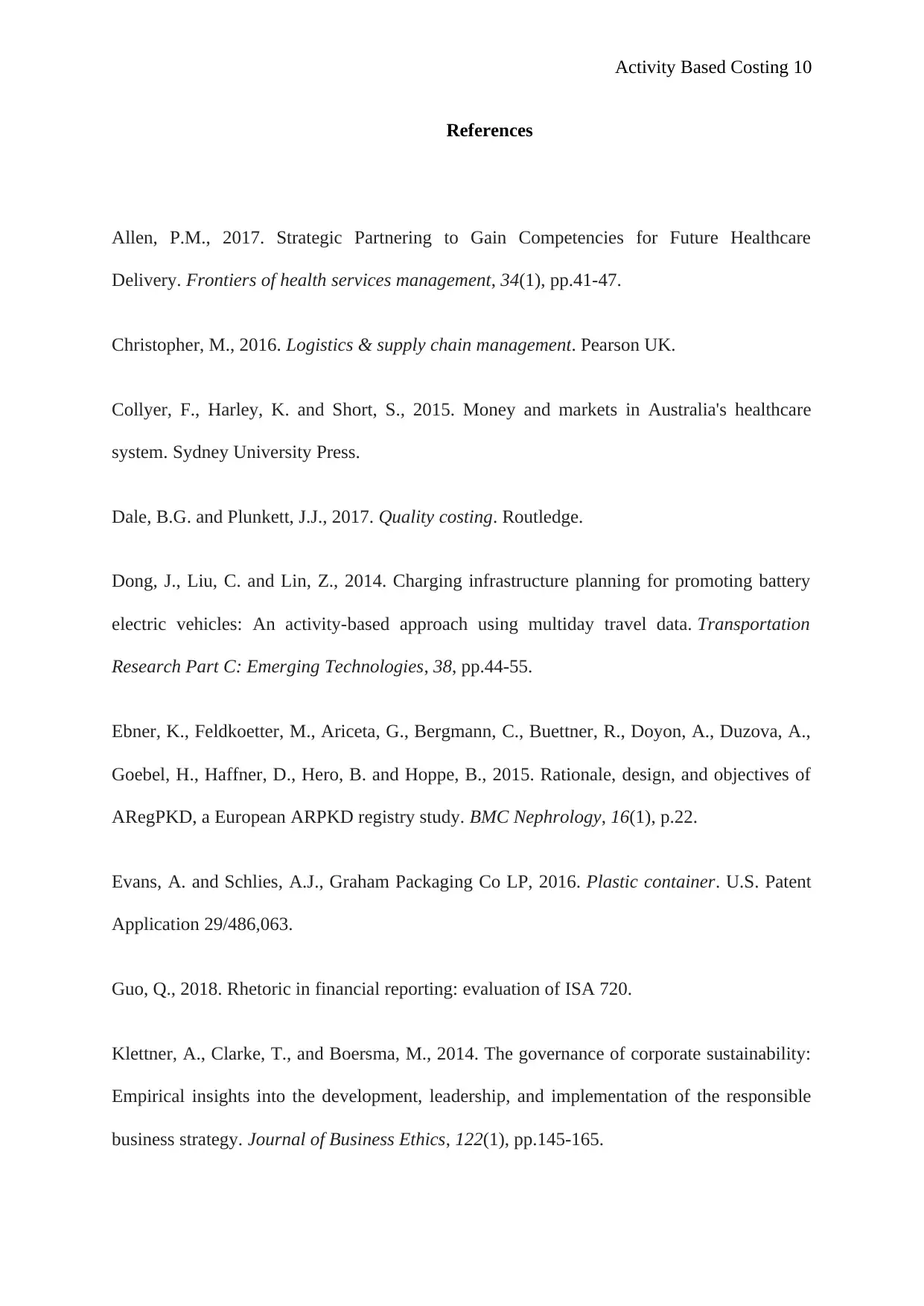
Activity Based Costing 10
References
Allen, P.M., 2017. Strategic Partnering to Gain Competencies for Future Healthcare
Delivery. Frontiers of health services management, 34(1), pp.41-47.
Christopher, M., 2016. Logistics & supply chain management. Pearson UK.
Collyer, F., Harley, K. and Short, S., 2015. Money and markets in Australia's healthcare
system. Sydney University Press.
Dale, B.G. and Plunkett, J.J., 2017. Quality costing. Routledge.
Dong, J., Liu, C. and Lin, Z., 2014. Charging infrastructure planning for promoting battery
electric vehicles: An activity-based approach using multiday travel data. Transportation
Research Part C: Emerging Technologies, 38, pp.44-55.
Ebner, K., Feldkoetter, M., Ariceta, G., Bergmann, C., Buettner, R., Doyon, A., Duzova, A.,
Goebel, H., Haffner, D., Hero, B. and Hoppe, B., 2015. Rationale, design, and objectives of
ARegPKD, a European ARPKD registry study. BMC Nephrology, 16(1), p.22.
Evans, A. and Schlies, A.J., Graham Packaging Co LP, 2016. Plastic container. U.S. Patent
Application 29/486,063.
Guo, Q., 2018. Rhetoric in financial reporting: evaluation of ISA 720.
Klettner, A., Clarke, T., and Boersma, M., 2014. The governance of corporate sustainability:
Empirical insights into the development, leadership, and implementation of the responsible
business strategy. Journal of Business Ethics, 122(1), pp.145-165.
References
Allen, P.M., 2017. Strategic Partnering to Gain Competencies for Future Healthcare
Delivery. Frontiers of health services management, 34(1), pp.41-47.
Christopher, M., 2016. Logistics & supply chain management. Pearson UK.
Collyer, F., Harley, K. and Short, S., 2015. Money and markets in Australia's healthcare
system. Sydney University Press.
Dale, B.G. and Plunkett, J.J., 2017. Quality costing. Routledge.
Dong, J., Liu, C. and Lin, Z., 2014. Charging infrastructure planning for promoting battery
electric vehicles: An activity-based approach using multiday travel data. Transportation
Research Part C: Emerging Technologies, 38, pp.44-55.
Ebner, K., Feldkoetter, M., Ariceta, G., Bergmann, C., Buettner, R., Doyon, A., Duzova, A.,
Goebel, H., Haffner, D., Hero, B. and Hoppe, B., 2015. Rationale, design, and objectives of
ARegPKD, a European ARPKD registry study. BMC Nephrology, 16(1), p.22.
Evans, A. and Schlies, A.J., Graham Packaging Co LP, 2016. Plastic container. U.S. Patent
Application 29/486,063.
Guo, Q., 2018. Rhetoric in financial reporting: evaluation of ISA 720.
Klettner, A., Clarke, T., and Boersma, M., 2014. The governance of corporate sustainability:
Empirical insights into the development, leadership, and implementation of the responsible
business strategy. Journal of Business Ethics, 122(1), pp.145-165.
Secure Best Marks with AI Grader
Need help grading? Try our AI Grader for instant feedback on your assignments.
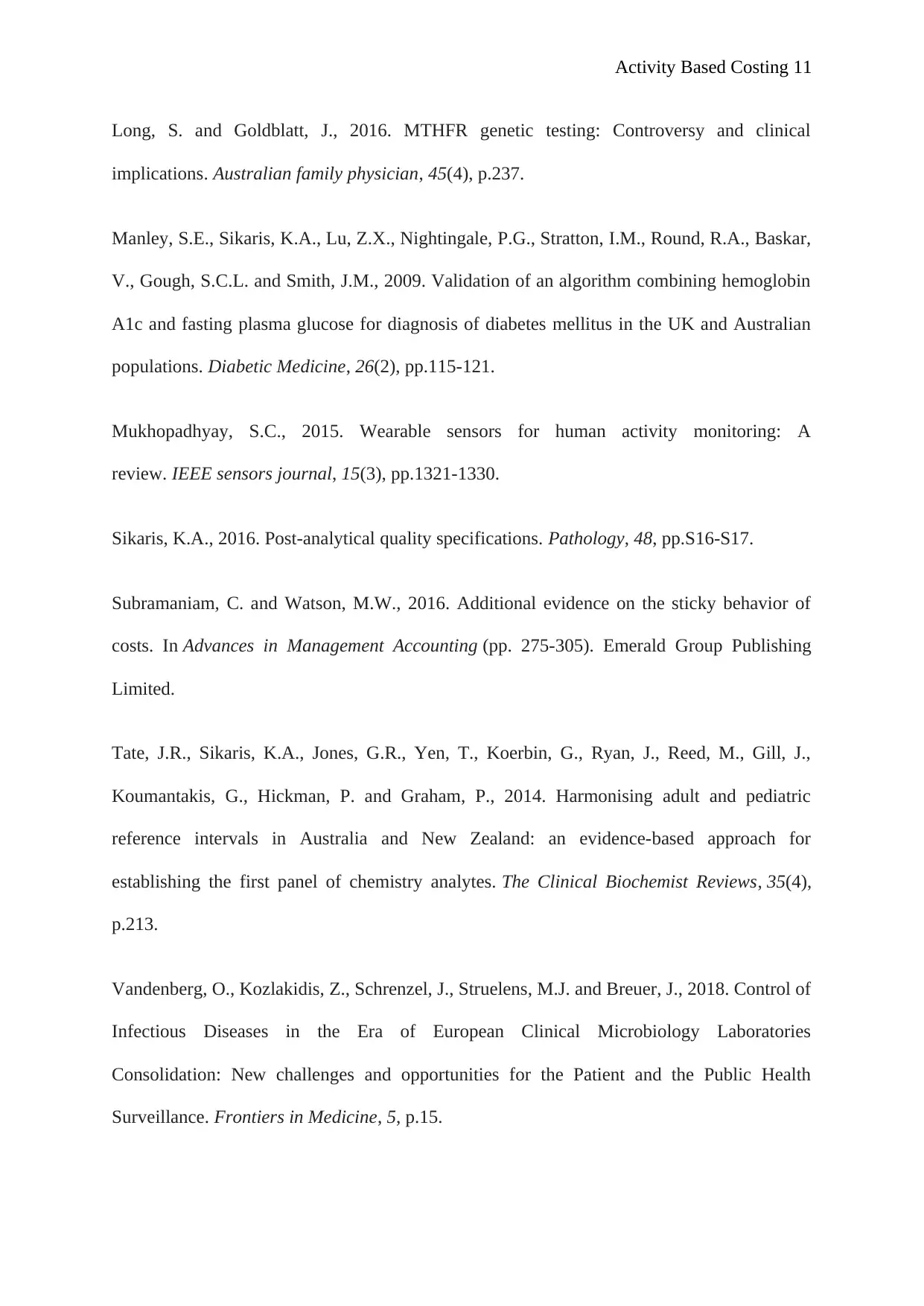
Activity Based Costing 11
Long, S. and Goldblatt, J., 2016. MTHFR genetic testing: Controversy and clinical
implications. Australian family physician, 45(4), p.237.
Manley, S.E., Sikaris, K.A., Lu, Z.X., Nightingale, P.G., Stratton, I.M., Round, R.A., Baskar,
V., Gough, S.C.L. and Smith, J.M., 2009. Validation of an algorithm combining hemoglobin
A1c and fasting plasma glucose for diagnosis of diabetes mellitus in the UK and Australian
populations. Diabetic Medicine, 26(2), pp.115-121.
Mukhopadhyay, S.C., 2015. Wearable sensors for human activity monitoring: A
review. IEEE sensors journal, 15(3), pp.1321-1330.
Sikaris, K.A., 2016. Post-analytical quality specifications. Pathology, 48, pp.S16-S17.
Subramaniam, C. and Watson, M.W., 2016. Additional evidence on the sticky behavior of
costs. In Advances in Management Accounting (pp. 275-305). Emerald Group Publishing
Limited.
Tate, J.R., Sikaris, K.A., Jones, G.R., Yen, T., Koerbin, G., Ryan, J., Reed, M., Gill, J.,
Koumantakis, G., Hickman, P. and Graham, P., 2014. Harmonising adult and pediatric
reference intervals in Australia and New Zealand: an evidence-based approach for
establishing the first panel of chemistry analytes. The Clinical Biochemist Reviews, 35(4),
p.213.
Vandenberg, O., Kozlakidis, Z., Schrenzel, J., Struelens, M.J. and Breuer, J., 2018. Control of
Infectious Diseases in the Era of European Clinical Microbiology Laboratories
Consolidation: New challenges and opportunities for the Patient and the Public Health
Surveillance. Frontiers in Medicine, 5, p.15.
Long, S. and Goldblatt, J., 2016. MTHFR genetic testing: Controversy and clinical
implications. Australian family physician, 45(4), p.237.
Manley, S.E., Sikaris, K.A., Lu, Z.X., Nightingale, P.G., Stratton, I.M., Round, R.A., Baskar,
V., Gough, S.C.L. and Smith, J.M., 2009. Validation of an algorithm combining hemoglobin
A1c and fasting plasma glucose for diagnosis of diabetes mellitus in the UK and Australian
populations. Diabetic Medicine, 26(2), pp.115-121.
Mukhopadhyay, S.C., 2015. Wearable sensors for human activity monitoring: A
review. IEEE sensors journal, 15(3), pp.1321-1330.
Sikaris, K.A., 2016. Post-analytical quality specifications. Pathology, 48, pp.S16-S17.
Subramaniam, C. and Watson, M.W., 2016. Additional evidence on the sticky behavior of
costs. In Advances in Management Accounting (pp. 275-305). Emerald Group Publishing
Limited.
Tate, J.R., Sikaris, K.A., Jones, G.R., Yen, T., Koerbin, G., Ryan, J., Reed, M., Gill, J.,
Koumantakis, G., Hickman, P. and Graham, P., 2014. Harmonising adult and pediatric
reference intervals in Australia and New Zealand: an evidence-based approach for
establishing the first panel of chemistry analytes. The Clinical Biochemist Reviews, 35(4),
p.213.
Vandenberg, O., Kozlakidis, Z., Schrenzel, J., Struelens, M.J. and Breuer, J., 2018. Control of
Infectious Diseases in the Era of European Clinical Microbiology Laboratories
Consolidation: New challenges and opportunities for the Patient and the Public Health
Surveillance. Frontiers in Medicine, 5, p.15.

Activity Based Costing 12
1 out of 12
Related Documents
Your All-in-One AI-Powered Toolkit for Academic Success.
+13062052269
info@desklib.com
Available 24*7 on WhatsApp / Email
![[object Object]](/_next/static/media/star-bottom.7253800d.svg)
Unlock your academic potential
© 2024 | Zucol Services PVT LTD | All rights reserved.





